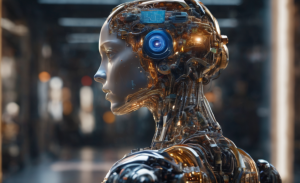How will AI change the user interface?
5 min readTable of Contents
Artificial intelligence (AI) represents a fundamental shift in the way computer technology is developed and deployed. Basically, it’s about a new way of interacting with people in the digital environment.
Much has been written about how AI enables a conversational form of interaction with computers, as opposed to the traditional methods of writing, clicking and typing.
In the future, users will likely need little or no training or skills to communicate with a digital system.
We will express our desires, and the intelligent bot, be it ChatGPT or another intelligent virtual assistant, will – or at least should – follow them.
But it’s not just about a new way to get something done. It is a fundamental shift in the relationship between biological intelligence (us) and the artificial intelligence we have created.
What is a User Interface?
A user interface (UI) is the means of operating a computer.
Be it a desktop/laptop, a mobile phone, an ATM or any other digital device, the interface is the way we express our desires.
Some user interfaces are very simple, such as: B. a keypad or even a button. Others require extensive knowledge or the ability to navigate a complex menu structure.
Some UIs require no user action at all: Retina scanners open doors just by looking at them. With toll transponders, a series of processes are triggered simply by driving past.
How has the user interface changed over the years?
The first interfaces date back to the earliest computers. The ENIAC-Machine was used during World War II by the University of Pennsylvania developed.
Similar to how telephone operators connected calls back in the day, it used a breadboard to transmit instructions from programmers to the vacuum tube-based device.
During the 1950s and 1960s, keyboards modeled on typewriters became the preferred means of operating computers. Their use was later expanded to include numerous special functions.
Most of these devices used batch processing and punch cards to convert ideas into programs. Eventually they evolved into command line interfaces that could be instantly displayed on screens.
The first graphical user interface (GUI) was developed in the 1970s by Xerox presented. Since then she has been used by Apple, IBM, Microsoft and others are continually updated for all kinds of computing devices.
What is Intent-Based UI?
Each of these earlier user interfaces simplified and streamlined what is essentially the same approach to programming: conveying exactly the process by which the computer should produce the expected result.
However, artificial intelligence represents a completely new approach because we no longer have to tell the device how to do something. Instead, we tell him what to do. An intelligent algorithm inside the machine then simply takes over the task.
This intent-based UI hands over much of the control to the AI model. This will fulfill your mission. The actual interaction between the user and the computer is drastically reduced.
Only if the results are incorrect or unsatisfactory does the user have to intervene again. This usually happens when the original intent was expressed incorrectly or unclearly.
What are the practical benefits of intent-based interfaces?
The Intent-Based UI not only saves a lot of time and effort, but also democratizes the great possibilities of the modern digital environment for people who would otherwise not have access to it.
Even the ubiquity of cell phones has not given everyone access to the connected world. Only those who take the time and effort will learn all the functions and features of their chosen interface.
However, with an intent-driven interface, all you have to do is express your desires or type them. The device then completes the task.
Many users already have the convenience of the question “Where is the cheapest gas near me?“ recognized. To get the answer, you don’t have to start an app, type in the query, and then zoom out on a map.
As AI applications become more innovative and sophisticated, this principle will also apply to more complex queries, such as: b. “Create an original graphic that shows sales for the next quarter“ or “Write a program that compares customer satisfaction with our most recently added features“.
What are the disadvantages?
Even with an intent-based interface, a computer is still a computer. Its performance is only as good as its programming and the data it can collect.
A poorly trained AI system with access to limited resources will produce erroneous results, and no user interface can change that.
Despite AI’s significant progress in decoding human language, it still falls short of capturing the numerous idiomatic phrases and expressions found in many languages around the world.
Therefore, interaction with AI via Intent-Based UI should occur somewhere in the middle between what humans say and what intelligent algorithms can understand.
Of course, this is significantly less time-consuming for the user than learning a programming language or diving into the depths of a menu-based platform.
What will come after the IB-UI?
Some experts talk about zero-command interfaces, similar to the scanners and toll transponders mentioned above, but aimed at more complex operations.
According to this concept, AI will be able to recognize what we want without us even having to express our desires.
When the quarterly sales meeting comes around, the sales data from the previous quarter will of course be needed. They need to be as comprehensive and forward-looking as possible.
If Tuesday is a shopping day, a list needs to be made, transportation organized, coupons and discounts accessed, etc.
That may be a tall order, but AI trends are driven by greater efficiency and convenience. The trick will be to train the algorithms to do what needs to be done.
However, they must not go so far as to take harmful measures that have to be reversed later.
Additionally, work is underway to enable AI to read brain scans and decode thoughts. There are even very simple direct interfaces between brain and computer (brain-to-computer interfaces, BCI).
Both developments already raise numerous ethical questions, even if they are still at a very early stage.
Crypto exchanges with the lowest fees 2023






